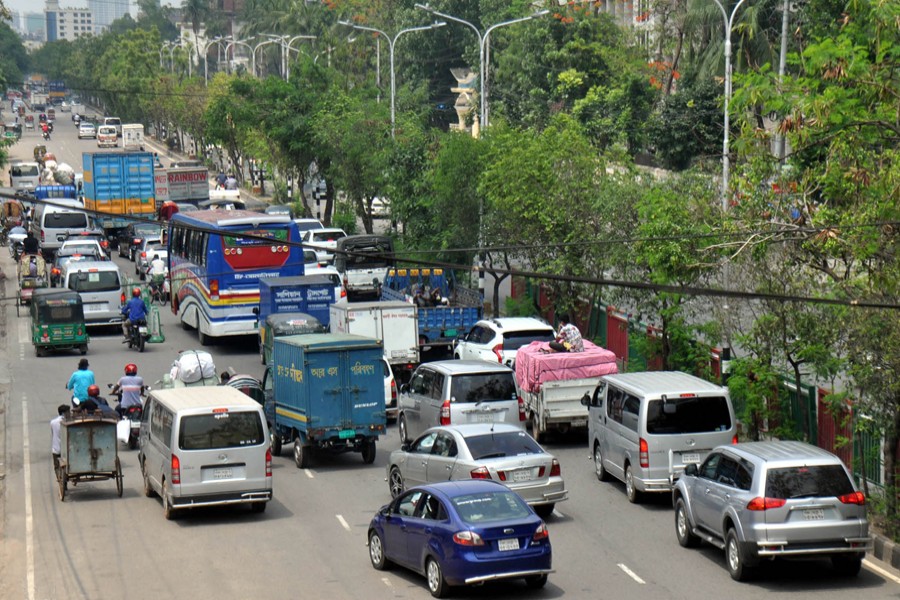Lockdown or social-distancing regime has witnessed some relaxation in recent days with movement of increased vehicles and commuters in Dhaka, posing a risk of further spreading COVID-19.
Languid maintenance of social-distancing guidelines among city-dwellers has been observed since the beginning of the holy month of Ramadan despite fast growth in COVID-19 detections.
Experts said people probably feel relaxed as the government allowed garment owners to partially open factories maintaining health safety measures prescribed by the World Health Organisation (WHO).
Besides, Dhaka, which is home to 20 million people, contains nearly 700,000 people living in slums or informal establishments.
Complying social-distancing rules for them is a big challenge.
The authorities also gave a positive signal to restaurants and food shops to reopen to sell takeaway iftar items amid increased demand from customers.
Allegations are still rife that many garment factories and restaurants are not maintaining social-distancing rules and health safety measures.
The relaxed atmosphere developed at a time when Bangladesh has picked up pace in the number of infected people in the past one week.
The country has recorded the highest number of coronavirus infections in a single day with 665 new cases in the past 24 hours until Sunday morning.
Two new deaths were also reported during the period.
The new cases took the number of confirmed COVID-19 cases to 9,455 with 177 deaths, said the regular press briefing of the Institute of Epidemiology, Disease Control and Research (IEDCR).
Bangabandhu Sheikh Mujib Medical University (BSMMU) former vice-chancellor Dr Nazrul Islam said, "The number of infections may climax by mid-May and would continue till the end of the month."
Dr Islam, also former chairman of virology department, suggested imposing strict social-distancing measures in the areas where most COVID-19 patients were detected.
As there is no medicine or antidote for the disease, social or physical distancing can only contain the spread of the virus and limit deaths from infections.
Rounds of general holidays have been in place across the country since March 26 to prevent community transmission which will continue until May 16.
On April 29, health minister Zahid Malik said Bangladesh can loosen lockdown since it has been going on for more than a month now.
He said factories can resume production on a limited scale by 'fully adhering' to physical distancing and other health safety rules to save economy.
Mr Malik gave examples of the US, Italy, France, New Zealand and some other European countries that decided gradual reopening of factories as infection showed signs of slowing down.
But factories in Bangladesh started opening while the rate of infections is yet to reach its peak.
According to the IEDCR data, Dhaka, Narayanganj and Gazipur are the current hotspots for coronavirus where most factories are located.
Meanwhile, Industrial Police data shows more than half of the total 7,602 registered garments factories have already started operations since April 26.
As the factories reopen, thousands of workers from across the country rushed to their respective workstations amid risks of coronavirus transmission.
In the meantime, low-income people, many of whom lost jobs due to the pandemic, flock to different parts of the city in desperate search of relief.
Many of them live in the squalor of slums where it is not possible to follow social-distancing guidelines.
Last June, local government, rural development and cooperatives minister Md Tazul Islam told parliament that 646,000 people live in 3,394 slums in Dhaka city.
Prof Saif Ullah Munshi, current chairman of virology department at BSMMU, said Bangladesh is now in fourth stage of COVID-19 transmission.
It is now hard to identify how or where a patient got infected, he went on to day.
Besides, the majority of the infected are asymptomatic who may go to work or come out of home to buy essential commodities ended up infecting others.
Besides, the number of tests, compared to the country's population size, needs to be increased substantially.
Prof Munshi suggested that the authorities concerned strictly control movement of people in most vulnerable areas with a large number of infected patients.
The WHO calls for maintaining social distancing which means keeping at least one metre (three feet) distance from a person who is coughing or sneezing.
Other measures include working from home, switching to online classes, visiting loved ones through electronic devices and cancelling or postponing conferences and large meetings.


